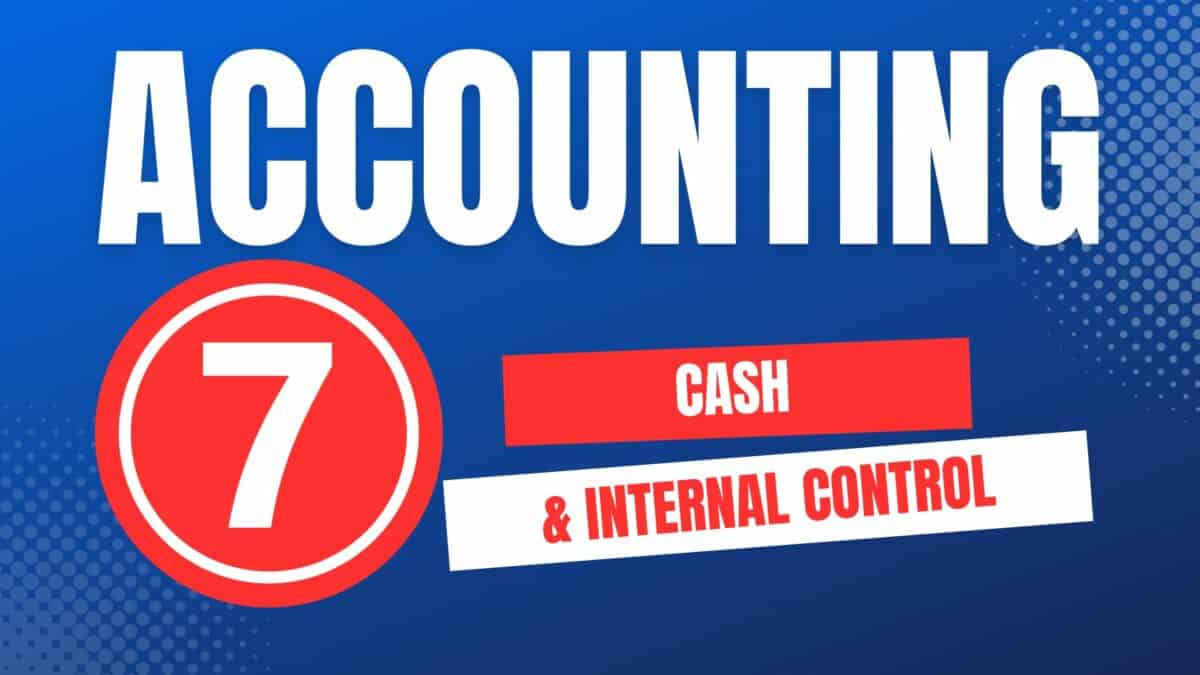Cash is a requirement for every business. Cash buys assets and services and pays liabilities. Effective cash management improves the company’s financial health.
This is Chapter 7 in Financial Accounting. This chapter includes:
For all the chapters, see The Ultimate Guide to Learn Financial Accounting
Contents
Internal control
Internal control is a system in accounting and auditing to protect assets and financial records. It is required to comply with legal requirements and improve the company efficiency.
4 objectives of internal control
There are four objectives of an internal control system. These help companies use an internal control system to ensure:
- Reliability of financial reporting: financial statements reflect the financial position of the firm
- Operational efficiency: company operations are effective and efficient
- Compliance with laws and regulations: company follows all laws, regulations and internal policies
- Safeguarding of assets: protects the company from theft, fraud, and damage
5 components of internal control
An effective internal control system includes 5 components:
- Control environment
- Risk assessment
- Control activities
- Information and communication
- Monitoring
The control environment sets the organizational tone. It includes integrity, ethical values, and competence of employees.
The firm performs a risk assessment that analyzes potential risks that may impede the achievement of its objectives.
Control activities are the policies and procedures that ensure management directives are carried out.
Information and communication include relevant information that enables employees to fulfill their responsibilities.
Monitoring involves regularly reviewing the system for effectiveness. This can be done through ongoing monitoring or periodic evaluations.
No internal control system can offer complete assurance due to inherent limitations, such as human error or collusion. However, a well-designed internal control system can provide reasonable assurance of achieving an organization’s objectives.
Sarbanes-Oxley Act
The Sarbanes-Oxley Act of 2002 (SOX) was a response to famous corporate scandals, including Enron and WorldCom. SOX introduced major changes to financial and corporate governance.
SOX was designed to restore public trust in the U.S. financial system. It imposes strict requirements on public companies and auditors to ensure the reliability of corporate disclosures.
Here are the key points of the Sarbanes-Oxley Act:
- Corporate Responsibility for Financial Reports: Executives must take individual responsibility for the accuracy of their firm’s financial reports.
- Increased Independence of External Auditors: SOX restricts auditing firms from performing certain non-audit services for the same clients to prevent conflicts of interest.
- Creation of the PCAOB: SOX established the Public Company Accounting Oversight Board (PCAOB) to oversee public company audits.
- Enhanced Financial Disclosures: SOX requires enhanced financial transparency and reporting requirements.
- Internal Control Requirements: Section 404, a controversial requirement, requires companies to annually assess and report on the effectiveness of their internal control. This has increased firms’ costs of compliance.
- Whistleblower Protection: SOX offers protection to corporate whistleblowers.
- Increased Penalties for Corporate Fraud: SOX adds strict penalties for financial record fraud. It also significantly increases penalties for securities fraud.
- Enhanced SEC Oversight: SOX gives the SEC more authority to regulate the financial reporting process.
Fraud and internal control
Effective internal control systems are crucial in reducing the risk of fraud within an organization.
Financial fraud can cause significant financial losses, damage a company’s reputation, and erode stakeholder trust.
Understanding factors that contribute to fraud is essential for implementing good internal control measures.
The fraud triangle is a way to understand the potential causes of fraud. The fraud triangle has three components:
- opportunity
- rationalization
- pressure
Opportunity is the chance to commit fraud without detection or consequences. Weak internal controls can create opportunities for theft.
The second component of the fraud triangle is rationalization. This is the justification that individuals develop to convince themselves that committing fraud is acceptable or necessary. Rationalizations often arise from financial difficulties, perceived grievances, or a sense of entitlement.
Pressure refers to external factors that exert significant stress on individuals. This may lead them to engage in fraud as a means to alleviate their financial burden. Some external pressures include increasing debts, gambling, or addiction problems
Internal control guidelines
The Committee of Sponsoring Organizations of the Treadway Commission (COSO) is an accounting profession organization that develops internal control guidelines. COSO develops the Internal Control—Integrated Framework, that provides internal control best practices.
The COSO framework allows a business to evaluate:
- internal controls
- risk management
- fraud deterrence
The COSO framework is used by businesses to design internal control systems for financial reporting and to evaluate their effectiveness.
Famous financial frauds
Financial fraud is knowing deception for financial gain Here is a list of famous financial frauds:
Enron
Enron was an energy company that is now synonymous for financial fraud. Enron’s management created misleading financial statements to hide billions in debt and inflate profits.
Enron’s bankruptcy was the largest in U.S. history at the time. This scandal led to the collapse of Arthur Andersen, one of the Big Five accounting firms.
The Enron scandal prompted the creation of the Sarbanes-Oxley Act to enhance financial disclosures and combat corporate fraud.
Bernie Madoff
Bernie Madoff operated the largest Ponzi scheme in history. He deceived investors by claiming consistent profits, but used funds from new investors to pay returns to earlier investors.
The Madoff fraud estimates were around $65 billion. Many investors, including individuals and charitable organizations, suffered significant financial losses. Madoff died in federal prison while serving a 150-year sentence.
WorldCom
WorldCom, a telecommunications company, admitted to inflating its assets by around $11 billion, making it one of the largest financial scandals ever.
WorldCom filed for bankruptcy, and its CEO, Bernard Ebbers, was sentenced to 25 years in prison.
Each of these frauds led to massive financial losses, eroded public trust, and, in many cases, resulted in significant regulatory changes to prevent similar future occurrences.
Accounting for cash
Cash is a requirement for every business. It takes cash to buy assets and services and to pay liabilities.
Liquidity shows the company’s ability to pay its short-term debts. Cash is a liquid asset because it is used to quickly pay liabilities.
Assets that can be sold quickly to convert to cash have higher liquidity. Land and other assets that are difficult to sell are illiquid assets.
Cash and cash equivalents
A company’s cash on the balance sheet includes cash and cash equivalents.
Cash includes coins, currency, demand deposits, and similar assets.
Cash includes:
- coins
- currency
- undeposited checks
- money orders
- checking accounts
- savings accounts
Cash equivalents include short-term liquid items that mature in three months or less. To be a cash equivalent, the investments must have a low risk of change in value.
Cash equivalents include:
- treasury bills
- money market funds
- commercial paper
- certificates of deposit
If these liquid investments have a maturity greater than three months, they are classified as marketable securities or short term investments.
Cash management
Cash management plays a pivotal role in the health of a business. Here are some reasons that show its importance:
1. Liquidity and solvency: Cash ensures that a business can meet its short-term obligations, from paying suppliers to settling interest on loans. Efficient cash management creates liquidity to increase solvency.
2. Operational needs: Cash funds the daily operations of a business. Remember, “cash is king.”
3. New opportunities: A cash reserve allows companies to seize potential investment opportunities, expand operations, or enter new markets without external financing.
4. Safety net: Effective cash management provides a safety net against business downturns and unexpected expenses.
5. Creditworthiness: Sufficient levels of cash increase credit ratings, with better loan terms and interest rates.
6. Dividends: Sufficient cash allows for paying dividends to shareholders, thereby increasing shareholder trust and attracting investments.
Bank reconciliation
A company keeps accounting records for its checking account. This is the book balance. The bank sends monthly bank statements to the company. A bank reconciliation reconciles the book balance and the bank balance.
A bank reconciliation serves as a verification tool. It ensures that the cash balances presented in a company’s books match the balances reported by the bank.
1. Error Detection: A bank reconciliation helps in identifying errors either in the bank records or in the company’s records.
2. Fraud Prevention: Bank reconciliations can help in the early detection of unauthorized transactions, indicating potential fraud or embezzlement.
3. Financial Integrity: A bank reconciliation ensures that financial statements reflect accurate cash balances, thereby increasing the reliability of financial reporting.
4. Cash Flow Management: By identifying outstanding checks and deposits in transit, businesses can better manage their liquidity and cash flows.
Preparing a bank reconciliation
1. Ending Balances: start with the ending cash balance in the company’s ledger to the ending balance on the bank statement.
2. Subtract Outstanding Checks: Deduct checks issued but not yet cashed by the recipients from the bank balance.
3. Add Deposits in Transit: Add deposits made by the business but not yet shown on the bank statement.
4. Correct Errors: Identify errors and correct them. This includes recording transactions missed or erroneously recorded.
5. Adjust for Bank Items: Include bank charges, interest earned, and other bank adjustments.
6. Book vs. Bank: After making all adjustments, the adjusted book balance should match the adjusted bank balance.
Bank reconciliation items
- Outstanding checks have been issued and recorded in the company’s books but have not cleared the bank. They are deducted from the bank balance during reconciliation.
- Deposits in transit are deposits by the company not yet reflected in the bank statement. They are added to the bank balance.
- Errors discovered need to be corrected. Errors can be found in the bank balance or the book balance.
- Bank fees are shown on the bank statement and should be deducted from the book balance.
- Interest earned increases the bank statement balance. The interest should be added to the bank balance.
Preparing bank reconciliations monthly maintains the integrity of a company’s financial records and helps to safeguard assets.
Internal control resources
- PCAOB: A Layperson’s Guide to Internal Control Over Financial Reporting
- Deloitte: The private company guide to effective internal controls
- SSRN: The FTX Crypto Debacle: Largest Fraud Since Madoff?
- COSO: Internal Control-Integrated Framework
Accounting Chapters
Here are the accounting chapters in The Ultimate Guide to Learn Accounting:
- Introduction to Accounting
- Recording Business Transactions
- Adjusting Entries and the Accounting Cycle
- Accounting for Merchandising Activities
- Inventory and Cost of Goods Sold
- Cash and Internal Control
- Accounting for Receivables
- Accounting for Long-Term Assets
- Accounting for Current Liabilities
- Accounting for Long-Term Liabilities
- Corporations
- Statement of Cash Flows
- Financial Statement Analysis
- Managerial Accounting
- Job Order Costing
- Process Costing
- Activity Based Costing
- Cost Volume Profit Analysis
- Variable Costing
- Master Budgets
- Standard Costing
- Performance Measurement
- Relevant Costing
- Capital Budgeting
- Time Value of Money
See also Accounting Sample Exams.

Jeff Mankin teaches financial literacy and Excel. He is the founder of Finally Learn.



